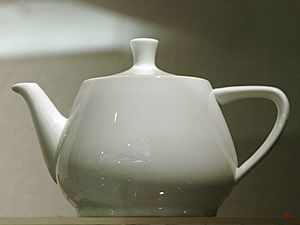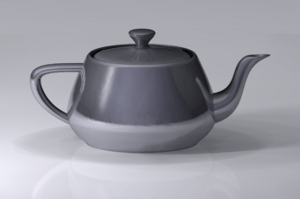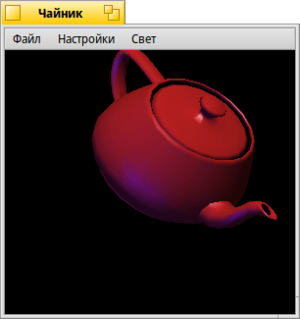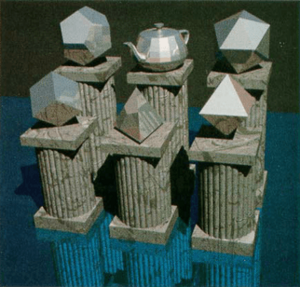Utah teapot facts for kids
The Utah teapot, also called the Newell teapot, is a special 3D shape. It became a very common object used for testing in the world of computer graphics. Think of it like a secret handshake or an in-joke among computer artists and programmers! It's a digital model of a regular Melitta brand teapot. It looks solid and is almost perfectly round when spun. Using the teapot model is like saying "Hello, World!" in 3D. It's an easy way to make a basic 3D scene. Some computer tools, like OpenGL Utility Toolkit, even have special commands just to draw teapots.
The teapot model was made in 1975 by Martin Newell. He was a computer graphics expert at the University of Utah. It was one of the first models created using special curves called bézier curves. These curves help make smooth, rounded shapes.
Contents
The Teapot's Amazing History

Martin Newell needed a simple, everyday object to test his new computer graphics ideas. His wife, Sandra Newell, suggested using their tea set. They were having tea at the time! He drew the teapot by hand on graph paper. Then, he used a computer to turn his drawing into a digital shape. He carefully set points for the bézier curves himself.
The teapot was perfect for early computer graphics tests. It was round and had interesting curves. It also had a hole for the handle, which made it more complex. Plus, it could cast a shadow on itself. It looked good without needing fancy textures.
Newell shared the mathematical information for his teapot. This data described the teapot's 3D shape. Soon, other researchers started using it for their own experiments. They needed a similar object, and using the teapot saved them a lot of work. Even as computers got better, the teapot remained a popular test object. It helped show off new and improved graphics techniques.
For many years, computer graphics magazines showed different versions of the teapot. There were smooth teapots, bumpy teapots, and even furry teapots!
The first teapot model did not have a bottom. It was not meant to be seen from below. Later versions of the digital data fixed this.
The real teapot is a bit taller than the computer model. Jim Blinn changed its height during a demonstration. He liked the way the new version looked, so they saved it that way.
Today, you can find versions of the teapot in almost every 3D program. This includes AutoCAD, 3ds Max, and OpenGL. Some programs even have a special command to draw it instantly. For example, the GLUT library has a function called `glutSolidTeapot()`. BeOS and Haiku operating systems show a spinning 3D teapot. This helps show off their multimedia features.
Teapot scenes are often used to test how fast and well a computer can draw graphics.
The Real Teapot's Story
The actual teapot was bought in 1974 from a store in Salt Lake City. It was given to a museum in Boston in 1984. Now, it lives at the Computer History Museum in Mountain View, California. It is called "Teapot used for Computer Graphics rendering." The company that made the original teapot, Friesland Porzellan, did not know about its fame until 2017! They then officially renamed it the "Utah Teapot." Martin Newell used the white "1,4L Utah Teapot" size.
Where the Teapot Appears
In 1987, a famous computer image showed six stone columns. Five columns had special geometric shapes called Platonic solids on top. The sixth column had a teapot! This image was called "The Six Platonic Solids." The artists joked that the teapot was a new shape called the "Teapotahedron." This picture appeared on many book covers.
The Utah teapot sometimes appeared in the "Pipes" screensaver on older versions of Microsoft Windows. It is also in the "polyhedra" XScreenSaver program.
Jim Blinn once used teapots to explain a math idea. He showed that if you draw a 2D teapot on each side of a right triangle, the area of the teapot on the longest side is equal to the sum of the areas of the teapots on the other two sides.
In the 1980 computer film Vol Libre, the teapot appears briefly. It is in front of a computer-generated mountain scene.
The Vulkan and OpenGL graphics tools even have the Utah teapot on their badges. It is shown with other famous 3D models like the Stanford dragon and the Stanford bunny.
As computer-made movies became popular, it became a fun tradition to hide the Utah teapot in scenes. For example, in the movie Toy Story, you can spot the Utah teapot in a tea-party scene. It also shows up in The Simpsons episode "Treehouse of Horror VI". In The Sims 2 game, you can buy a painting of the Utah teapot. It is called "Handle and Spout."
An origami (folded paper) version of the teapot was made by Tomohiro Tachi. It was shown in a museum exhibit in Israel.
Turning the Teapot into OBJ Files
The original teapot data uses a special format. This can be hard to use in many 3D programs. So, people often convert it into a common file type called OBJ. This makes it easier to use the teapot model. You can find a converted version of the whole teapot set online. It is available on the University of Utah website.
3D Printed Teapots
The Utah Teapot has come full circle! It started as a real teapot, became a computer model, and now it can be a real teapot again thanks to 3D printing. You can find 3D printed teapots made from plastic or even ceramic. Some are printed to look "low poly." This means they have fewer flat surfaces, which reminds people of its early computer model days.
In 2009, a design studio in Belgium 3D printed the Utah Teapot in ceramic. They wanted to make it a useful object again. They also wanted to show its importance as a digital symbol.
In 2015, a company in California printed the teapot, cups, and spoons out of actual tea!
Gallery
See also
 In Spanish: Tetera de Utah para niños
In Spanish: Tetera de Utah para niños






